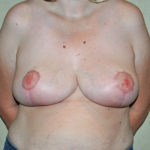Large breasts that hang are almost always associated with neck, back, and shoulder discomfort. The key sign that breasts are too heavy and are a source of discomfort and posture problems is shoulder grooving…bra straps lines that have indented the shoulder tissues due to the weight of the breasts that they must support. Breast reduction surgery is extraordinarily effective at improving these symptoms, almost regardless of the amount of breast tissue removed.
One of the primary objectives of any form of breast reduction surgery is preservation of the nipple-areolar complex. While the inferior pedicle technique still remains the most common type of breast reduction performed in the United States, other variations exist. But no matter how the breast mound is reduced, maintaining a blood supply to its only functioning element is how these operations are designed.
In breasts of extreme size, however, concern always arises about how a lot of breast tissue removal may affect the survival of the nipple. (interfere with the blood vessels feeding it) Loss of a nipple due to necrosis after breast reduction is a known risk… but knowing that it can happen and then having it happen to you doesn’t make you feel any better. While there is no exact way to predict whether a nipple will or will not survive after breast reduction, suffice it to say that the larger the breast reduction the greater the potential risk.


Breast reduction with free nipple grafting is an option for those women who have very large breasts that are not concerned with how the nipple functions. Whether this is a good variation for any woman’s breast reduction must be considered on an individual basis. In my Indianapolis plastic surgery practice in the past several years, I am seeing more women than I can ever remember that are choosing this option.
Dr. Barry Eppley
Indianapolis, Indiana




